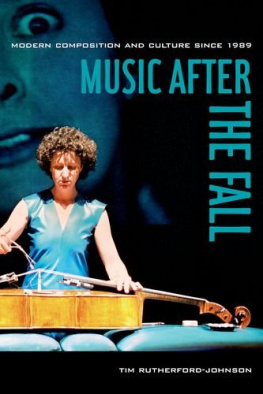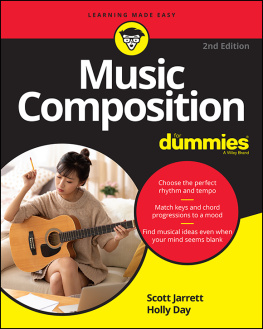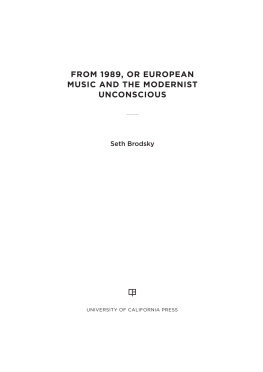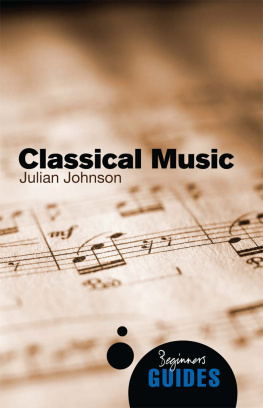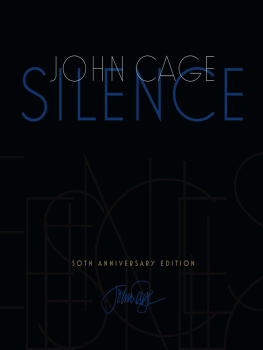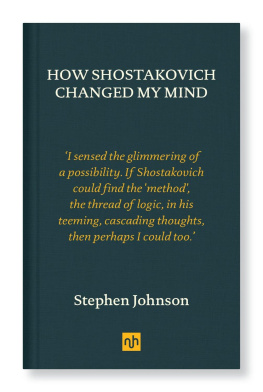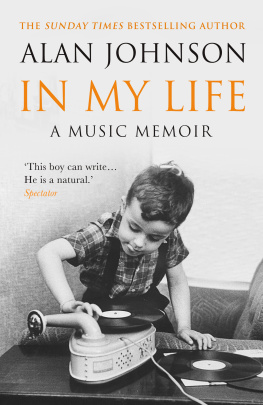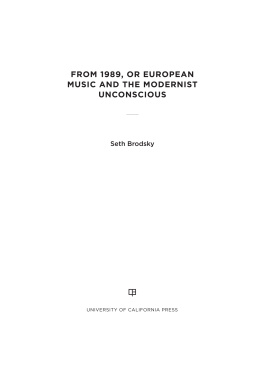Tim Rutherford-Johnson - Music After the Fall: Modern Composition and Culture Since 1989
Here you can read online Tim Rutherford-Johnson - Music After the Fall: Modern Composition and Culture Since 1989 full text of the book (entire story) in english for free. Download pdf and epub, get meaning, cover and reviews about this ebook. year: 2017, publisher: University of California Press, genre: Romance novel. Description of the work, (preface) as well as reviews are available. Best literature library LitArk.com created for fans of good reading and offers a wide selection of genres:
Romance novel
Science fiction
Adventure
Detective
Science
History
Home and family
Prose
Art
Politics
Computer
Non-fiction
Religion
Business
Children
Humor
Choose a favorite category and find really read worthwhile books. Enjoy immersion in the world of imagination, feel the emotions of the characters or learn something new for yourself, make an fascinating discovery.
- Book:Music After the Fall: Modern Composition and Culture Since 1989
- Author:
- Publisher:University of California Press
- Genre:
- Year:2017
- Rating:3 / 5
- Favourites:Add to favourites
- Your mark:
- 60
- 1
- 2
- 3
- 4
- 5
Music After the Fall: Modern Composition and Culture Since 1989: summary, description and annotation
We offer to read an annotation, description, summary or preface (depends on what the author of the book "Music After the Fall: Modern Composition and Culture Since 1989" wrote himself). If you haven't found the necessary information about the book — write in the comments, we will try to find it.
Music After the Fall: Modern Composition and Culture Since 1989 — read online for free the complete book (whole text) full work
Below is the text of the book, divided by pages. System saving the place of the last page read, allows you to conveniently read the book "Music After the Fall: Modern Composition and Culture Since 1989" online for free, without having to search again every time where you left off. Put a bookmark, and you can go to the page where you finished reading at any time.
Font size:
Interval:
Bookmark:

IMPRINT IN HUMANITIES
The humanities endowment
by Sharon Hanley Simpson and
Barclay Simpson honors
MURIEL CARTER HANLEY
whose intellect and sensitivity
have enriched the many lives
that she has touched.
The publisher gratefully acknowledges the generous support of the Simpson Humanities Endowment Fund of the University of California Press Foundation.
Tim Rutherford-Johnson

UNIVERSITY OF CALIFORNIA PRESS
University of California Press, one of the most distinguished university presses in the United States, enriches lives around the world by advancing scholarship in the humanities, social sciences, and natural sciences. Its activities are supported by the UC Press Foundation and by philanthropic contributions from individuals and institutions. For more information, visit www.ucpress.edu.
University of California Press
Oakland, California
2017 by The Regents of the University of California
Library of Congress Cataloging-in-Publication Data
Names: Rutherford-Johnson, Tim, author.
Title: Music after the fall : modern composition and culture since 1989 / Tim Rutherford-Johnson.
Description: Oakland, California : University of California Press, [2017] | Includes bibliographical references and index.
Identifiers: LCCN 2016040711 | ISBN 9780520283145 (cloth : alk. paper) | ISBN 9780520283152 (pbk. : alk. paper) | ISBN 9780520959040 (ePub)
Subjects: LCSH : Music20th centuryHistory and criticism. | Music21st centuryHistory and criticism. | MusicSocial aspectsHistory20th century. | MusicSocial aspectsHistory21st century.
Classification: LCC ML 197 . R 94 2017 | DDC 780.9/04dc23
LC record available at https://lccn.loc.gov/2016040711
Manufactured in the United States of America
26 25 24 23 22 21 20 19 18 17
10 9 8 7 6 5 4 3 2 1
This ones for Liz, Mizzle, and Conks.
Throughout this books gestation and creation, many people gave generously of their time, ideas, and materials, both in formal interviews and informal conversations, virtually and in meatspace. I hope I can catch at least the most important ones here.
Among the composers, Richard Barrett, Aaron Cassidy, Evan Johnson, and Liza Lim have provided endless conversations, materials, and inspirations. Chaya Czernowin, Cassandra Miller, Alwynne Pritchard, James Saunders, Charlie Sdraulig, and Carl Stone were all generous with time, conversations, and materials. Philipp Blume, Daniel James Wolf, and Alistair Zaldua have proved excellent online companions, introducing me to more revelatory musical experiences than I thought possible. Michel van der Aa provided opportunities to write. Among the performers, I owe a particular debt of thanks for conversations, perspectives, and kickass musicianship to Daryl Buckley and the players of ELISION, as well as to Mark Knoop, Anton Lukoszevieze, Ian Pace, Heather Roche, Carl Rosman, and Philip Thomas.
Among the writers and scholars, Paul Griffiths and Alex Ross have provided both inspiration and encouragement. As a mentor, Keith Potter has provided support and direction for nearly two decades. An early conversation with Adrian Thomas strengthened my resolve to turn my ideas into a book. Seth Brodsky, Roddy Hawkins, and Lauren Redhead generously shared unpublished research. I have had invaluable conversations with Lawrence Dunn, John Fallas, Stephen Graham, Martin Iddon, and Tom Perchard. Andreas Engstrm, Larry Goves, and Nick Reyland all provided opportunities to present some of my work in public. Jennie Gottschalk bravely read my early drafts and has been an invaluable co-conspirator throughout. Christopher Fox, Will Robin, Chris Swithinbank, and Jennifer Walshe also read chapters and saved me from embarrassment on several occasions. (Any remaining errors are all mine.) David Mendoza made valuable criticisms of articles I published on NewMusicBox, and which I later incorporated into chapter 5 of this book. Vincenzo Donato suggested some architectural examples for chapter 8. Finally, I am grateful to the various reviewers of this books proposal and manuscript, whose comments have improved the book immeasurably.
Among the editors, the enthusiasm and support of Mary Francis at University of California Press from this books formal beginning and into its afterness has been awe-inspiring. I am indebted also to Marys successor at UC Press, Raina Polivka, who guided the book over the finishing line, and to my copyeditor, Genevieve Thurston, who seemed to improve almost every line. Laura Macy, John Tyrrell, and Charles Wilson, as editors at the New Grove, gave me an old-fashioned and irreplaceable education in the written word and an unrivalled opportunity to learn about living composers. Molly Sheridan of NewMusicBox never turned down a pitch. Edward Bhesania at the BBC gave me opportunities to write about countless works in the form of program notes, many elements of which have found their way into the present text. Malcolm MacDonald and Bob Gilmore were supportive editors at Tempo and great servants to new music writing in the United Kingdom. Both passed away while this book was being written; both are very sadly missed.
I will be forever grateful to John and Sue for providing writing sanctuaries, in both Sussex and Suffolk, and to my White Crane instructor, Richard Wagstaff, for keeping my mind and body on track. A generous grant from the Hinrichsen Foundation helped see the book through its final few months. And nothing would have been possible without the limitless support and encouragement of my parents, Linda and Martin Johnson.
Finally, with endless love, I thank Elizabeth for throwing down this particular gauntlet and being my ideal reader ever since.
It begins with a string quartet: two violins, a viola, and a cello pumping notes up and down like pistons. An image of the American machine age, hallucinated through the sound of the European Enlightenment. The image is strengthened as a voicemature, female, Americanintones an itinerary: From Chicago... to New York. The sound is prerecorded, digitally sampled and amplified through speakers beside the ensemble. More samples are added: more voices; the whistles and bells of trains; one, two, three, or even more string quartets. Rapidly the musical space far exceeds what we see on stage. This is a string quartet for the media age, as much recordings and amplification as it is the four musicians in front of us. Yet everything extends from it and back into it, whether the quartet of quartets, which mirror and echo each other; the voices, which seem to blend seamlessly with the instrumental rhythms and melodies; or the whistles, which mesh so clearly with the harmonic changes that it seems certain they come from an unseen wind instrument and not a concrete recording.
It begins with thumping and hammering, small clusters struck on the piano keyboard with the side of the palm or with three fingers pressed together, jabbing like a beak. The sound recalls a malevolent dinosaur or perhaps a furious child, but it isnt random; a melody of sorts, or an identifiable series of pitches at least, hangs over the tumult. After twenty seconds or so the thunder halts abruptly for a two-note rising motif played by the right hand, which is then imitated (slightly altered) by the left. It is a simple gesture, refusing, with that delicate variation on the repeat, to do as expected, and expressed with the utmost clarity and efficiency. We have jumped from breezeblocks to water, but the expressive force remains. At every turn the musicon paper just a short sonata for pianoseems about to burst its own edges. Distortion is applied in every dimension, from the blurring of the melodic line with those cluster chords, to the extremities of force and volume required from instrument and performer (for the majority of the piece, every note is marked to be played very loud, except those marked even louder), to the extremes of range, from the very highest to the very lowest notes of the piano that stretch any sense of sonic unity or middle ground to its limit. Even at just seven minutes long, it is a shattering experience for both performer and listener, only heightened by the few moments of quiet contemplation that occur toward the end of the piece.
Font size:
Interval:
Bookmark:
Similar books «Music After the Fall: Modern Composition and Culture Since 1989»
Look at similar books to Music After the Fall: Modern Composition and Culture Since 1989. We have selected literature similar in name and meaning in the hope of providing readers with more options to find new, interesting, not yet read works.
Discussion, reviews of the book Music After the Fall: Modern Composition and Culture Since 1989 and just readers' own opinions. Leave your comments, write what you think about the work, its meaning or the main characters. Specify what exactly you liked and what you didn't like, and why you think so.

